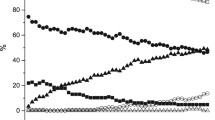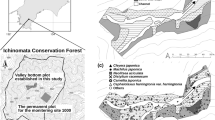Abstract
Spatial distribution is fundamental for understanding species coexistence mechanisms in forest communities. Here we comprehensively explored fine-scale spatial patterns of tree species in a secondary warm-temperate deciduous broad-leaved forest community in north China. Aggregated distribution patterns were predominant. Species functional traits had no significant effects on their spatial patterns. The aggregation intensity decreased with increasing DBH and abundance. The multivariate linear stepwise regression showed that abundance and maximum DBH were correlated with the aggregation intensity. Our results partially confirm that species attributes (abundance, DBH) and habitat heterogeneity may primarily contribute to spatial patterns and species coexistence in this secondary forest.



Similar content being viewed by others
References
Baddeley A, Rubak E, Turner R (2015) Spatial point patterns: methodology and applications with R. Chapman and Hall/CRC Press, London
Condit R (1998) Tropical forest census plots: methods and results from Barro Colorado Island, Panama and a comparison with other plots. Springer, Berlin
Condit R, Ashton PS, Baker P, Bunyavejchewin S, Gunatilleke S, Gunatilleke N et al (2000) Spatial patterns in the distribution of tropical tree species. Science 288(5470):1414–1418
Gu Y, Zhang S, Li X, Li Z (2013) Relationship between diameter at breast height and age of endangered species Populus Euphratica Oliv. J Tarim Univ 25(2):66–69
Guo Y, Lu J, Franklin SB, Wang Q, Xu Y, Zhang K, Bao D, Qiao X, Huang H, Lu Z, Jiang M (2013) Spatial distribution of tree species in a species-rich subtropical mountain forest in central China. Can J For Res 43(9):826–835
Harms KE, Wright SJ, Calderon O, Hernandez A, Herre EA (2000) Pervasive density-dependent recruitment enhances seedling diversity in a tropical forest. Nature 404(6777):493–495
Harms KE, Condit R, Hubbell SP, Foster RB (2001) Habitat associations of trees and shrubs in a 50-ha neotropical forest plot. J Ecol 89(6):947–959
Hett JM, Loucks OL (1976) Age structure models of balsam fir and eastern hemlock. J Ecol 64(3):1029–1044
Hubbell SP (2001) The unified neutral theory of biodiversity and biogeography. Princeton University Press, Princeton
Lai J, Mi X, Ren H, Ma K (2009) Species-habitat associations change in a subtropical forest of China. J Veg Sci 20(3):415–423
Leak WB (1975) Age distribution in virgin red spruce and northern hardwoods. Ecology 56(6):1451–1454
Li L, Huang Z, Ye W, Cao H, Wei S, Wang Z, Lian J, Sun IF, Ma K, He F (2009) Spatial distributions of tree species in a subtropical forest of China. Oikos 118(4):495–502
Liu HF, Xue DY, Sang WG (2014) Species diffusion and niche differentiation of the warm temperate deciduous broad-leaved forest in its functional development process. Chin Sci Bull 59:2359–2366 (in Chinese)
Lorimer CG (1980) Age structure and disturbance history of a southern Appalachian virgin forest. Ecology 61(5):1169–1184
Lorimer CG, Krug AG (1983) Diameter distributions in even-aged stands of shade-tolerant and Midtolerant Tree Species. Am Midl Nat 109(2):331–345
Meng X (1989) Analyses for structure of age in natural Larix gmelinii stands. J Beijing For Univ 11(3):17–23
Peng S, Xu G (2005) Seed traits of Castanopsis Chinensis and its effects on seed predation patterns in Dinghushan Biosphere Reserve. Ecol Environ 14:493–497
Pu X, Jin G (2018) Conspecific and phylogenetic density-dependent survival differs across life stages in two temperate old-growth forests in Northeast China. For Ecol Manag 424:95–104
Seidler TG, Plotkin JB (2006) Seed dispersal and spatial pattern in tropical trees. PLoS Biol 4(11):e344
Su H, Li G (2012) Simulating the response of the Quercus mongolica forest ecosystem carbon budget to asymmetric warming. Chin Sci Bull 57:1544–1552 (in Chinese)
Wang X, Hao Z, Zhang J, Lian J, Li B, Ye J, Yao X (2010a) Tree size distributions in an old-growth temperate forest. Oikos 118(1):25–36
Wang X, Ji Y, Li B, Jian Z, Fei L, Hao Z (2010b) Spatial distributions of species in an old-growth temperate forest, northeastern China. Can J For Res 40(6):1011–1019
Wiegand T, Moloney KA (2004) Rings, circles, and null-models for point pattern analysis in ecology. Oikos 104(2):209–229
Wiegand T, Moloney KA (2014) Handbook of spatial point-pattern analysis in ecology. CRC Press, Boca Raton
Wiegand T, Uriarte M, Kraft NJB, Shen G, Wang X, He F (2017) Spatially explicit metrics of species diversity, functional diversity, and phylogenetic diversity: insights into plant community assembly processes. Annu Rev Ecoll Evol Syst 48(1):329–351
Wills C, Condit R (1999) Similar non-random processes maintain diversity in two tropical rainforests. Proc R Soc B Biol Sci 266(1427):1445–1452
Yu X, Zhou H, Luo T (2001) Patterns of damage by phytophagous insects on leaves of quercus liaotungensis. Acta Phytoecologica Sinica 25(5):553–560
Yu X, Zhou H, Luo T (2002) Interactions of insects and oak trees and their impacts on the regeneration of oakwoods. Biodivers Sci 10(2):225–231
Zhao Y, Zhang L (2005) Investigation of pests for wild trees in Changbai Mountains. J Northeast For Univ 33:107–109 (in Chinese)
Zhu Y, Comita LS, Hubbell SP, Ma K (2015) Conspecific and phylogenetic density–dependent survival differs across life stages in a tropical forest. J Ecol 103(4):957–966
Zhu Y, Queenborough SA, Condit R, Hubbell SP, Ma K, Comita LS (2018) Density-dependent survival varies with species life-history strategy in a tropical forest. Ecol Lett 21(4):506
Zou Y, Sang W, Wang S, Warrenthomas E, Liu Y, Yu Z, Wang C, Axmacher JC (2015) Diversity patterns of ground beetles and understory vegetation in mature, secondary, and plantation forest regions of temperate northern China. Ecol Evol 5(3):531–542
Acknowledgements
We are grateful to many field workers for their contributions to the establishment and first census of the 20-ha DLS forest dynamics plot. This study was supported by the National Key R&D Program of China (2017YFC0505601), the National Natural Science Foundation of China (31570630) and State Key Laboratory of Forest and Soil Ecology (LFSE2015-13).
Author information
Authors and Affiliations
Corresponding author
Additional information
Publisher's Note
Springer Nature remains neutral with regard to jurisdictional claims in published maps and institutional affiliations.
Project funding: This study was supported by the National Key R&D Program of China (2017YFC0505601), the National Natural Science Foundation of China (31570630) and State Key Laboratory of Forest and Soil Ecology (LFSE2015-13).
The online version is available at http://www.springerlink.com
Corresponding editor: Chai Ruihai.
Rights and permissions
About this article
Cite this article
Gu, H., Li, J., Qi, G. et al. Species spatial distributions in a warm-temperate deciduous broad-leaved forest in China. J. For. Res. 31, 1187–1194 (2020). https://doi.org/10.1007/s11676-019-00928-7
Received:
Accepted:
Published:
Issue Date:
DOI: https://doi.org/10.1007/s11676-019-00928-7




